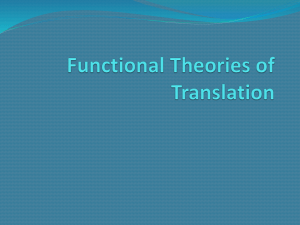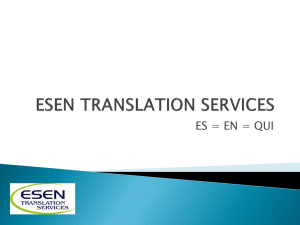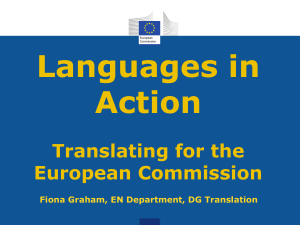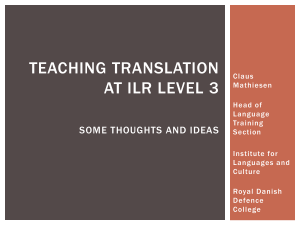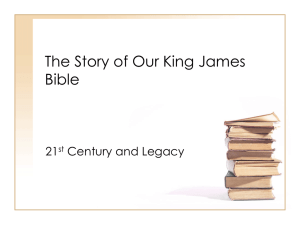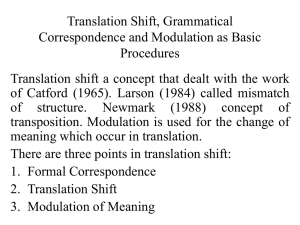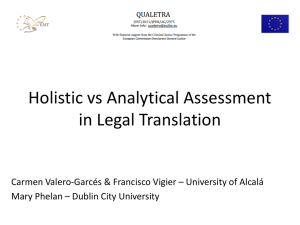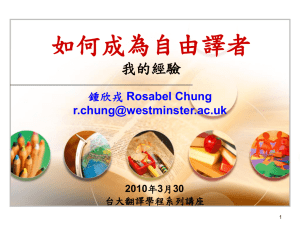Sosoni Semester E` 2009
advertisement
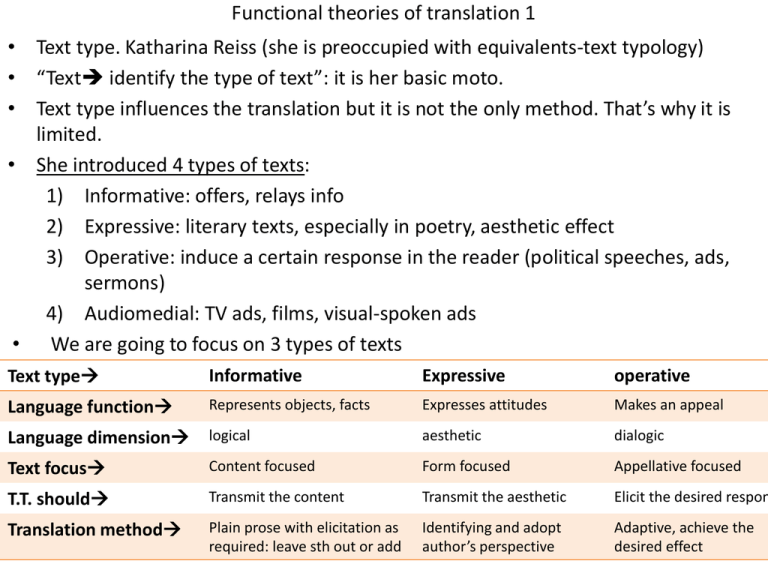
Functional theories of translation 1 • Text type. Katharina Reiss (she is preoccupied with equivalents-text typology) • “Text identify the type of text”: it is her basic moto. • Text type influences the translation but it is not the only method. That’s why it is limited. • She introduced 4 types of texts: 1) Informative: offers, relays info 2) Expressive: literary texts, especially in poetry, aesthetic effect 3) Operative: induce a certain response in the reader (political speeches, ads, sermons) 4) Audiomedial: TV ads, films, visual-spoken ads • We are going to focus on 3 types of texts Text type Informative Expressive operative Language function Represents objects, facts Expresses attitudes Makes an appeal Language dimension logical aesthetic dialogic Text focus Content focused Form focused Appellative focused T.T. should Transmit the content Transmit the aesthetic Elicit the desired respon Translation method Plain prose with elicitation as required: leave sth out or add Identifying and adopt author’s perspective Adaptive, achieve the desired effect Functional theories of translation 2 • Hybrid e.g. texts that are both informative, expressive and operative (satire). Ads are also hybrid texts because their predominant nature is operative but they also try to inform us about sth. Informative: reference work, report, lecture, manuals/operating instructions Expressive: Play, poem • • Satire Operative: sermon, electoral speech, ads We should start our translation by identifying the type of text we have in front of us Examples of function change: – – – Language function changes when e.g. literary texts are used to teach. Gulliver’s travels started as operative texts but became expressive. The changes in function are decided by the commissioner, not us In hybrid texts, we adopt the translation of the predominant text type Texts form photocopies (handouts) • Text 1: Upon the roof Informative text, journalistic article. It also expresses the reader’s attitude. There are also traces of operative text (hybrid text). There are many functions but the predominant function is to inform. • Text 2: New law on DNA testing Purely informative text, legal text. We translate according to the Plain Prose. • Text 3: Atomic fingerprinting Informative, scientific text • Text 4: Hepatocellular carcinoma Informative, medical text • Text 5: Linguistic theory and issues of prescription/description informative text, author is against descriptivism. There are traces of expressive text- Hybrid text • Text 6: the picture of Dorian grey expressive text, literary text The predominant nature of ads is operative but they may also try to inform us about issues Hybrid Functional theories of translation 3 • Skopos theory: (1984) Groundwork for a general Theory of Translation • Hans Vermeer/ Katharina Reiss they claim that the translation is an action Skopos = an intended purpose Their theory dethrones the source text. They focus on the TT (translatum) • The translation started with the translation of the Bible and general literary texts • Functional approaches specialized texts • Rules underlining Skopos theory: 1) A T.T. is determined by its skopos 2) A T.T. is an offer of info in the T.C. (target culture) and T.L. concerning an offer of info in the S.C. and S.L. (we need to know the function of T.T.) 3) A T.T. is not clearly reversible 4) A T.T. must be internally coherent 5) A T.T. must be coherent with the S.T. 6) The above rules appear in a hierarchical order with rule 1 being predominant. This theory really holds for specialized texts e.g. a medical-scientific text translated for the general public. Vermeer and Reiss talk about Adequacy and not Equivalence Adequacy is the fulfillment of the skopos of T.T. Functional theories of translation 4 • Holz Manttari (1984) • Translational or translatorial action • Her theory is based on action and communication theory. She suggests that translation doesn’t involve translation of sentences of text but translation is a communication process. a) The initiator (the person or company that initiates translation) b) The commissioner c) S.T. producer (the author of the text) d) T.T. producer (the translator) e) T.T. user f) T.T. receiver (the recipients: general public) BUT if sb is the author of a text, the author might also be the commissioner, producer, initiator and the user. Functional theories of translation 5 [Holz Manttari (1984)] MAIN POINTS OF THE THEORY The translator should: 1) Produce a T.T. functionally for the T.T. receiver. This cannot be done by following the S.T. We have ultimate freedom of translation 2) Negotiate with the commissioner the time and process of translation 3) Analyze the text in terms of content and form Content a. factual information b. overall communicative stategy (the strategy/ the way the author writes) Form a. terminology b. cohesive elements e.g. cohesion: The council of Ministers= το συμβούλιο των υπουργών synonyms The council of the European= το συμβούλιο της Ε.Ε. The Treaty of Maastricht synonyms The Treaty of European Union • Terminology ≠ Register e.g. For example= high register: επί παραδείγματι – low register: για παράδειγμα IMPORTANTit’s the only theory which linked the translator with the commissioner. Freedom to the translator (which is also dangerous)
